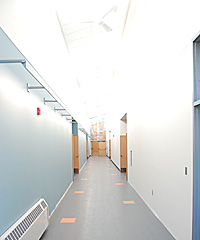By Daniel Levisohn, Assistant Editor, JTNews
Though the overhead lights are still wrapped in plastic and the stairs await slip-resistant rubber trimmings, in a matter of weeks the new K’hilah Center at Temple Beth Am will welcome its first batch of religious school students, before an official dedication on Simchat Torah.
The 20,000-square-foot K’hilah Center, which translates as “ community,” boasts 12 new classrooms, an expanded youth lounge and art room, and one-third more social gathering space designed to serve the needs of Temple Beth Am’s rapidly growing congregation, which has nearly tripled in the last decade and supports a 600-student religious school that meets twice a week.
“Beth Am wants to focus on being [a] center of Jewish civilization,” said Jonathan Singer, Temple Beth Am’s head rabbi, explaining that the congregation should be a place where Jews won’t only gather to pray, but to make new connections, explore culturally, and grow religiously. “The K’hilah Center is just that.”
The new facility has classrooms both upstairs and downstairs, with overhead lights that automatically adjust their brightness based upon the amount of sunlight entering from the outside. The upstairs classrooms have sloping ceilings, giving the rooms added breathing space, and the entire facility is handicapped accessible. According to Esther Herst, Temple Beth Am’s executive director, the congregation wants to use the K’hilah Center’s tall hallways walls to display the artwork produced by the many artists, old and young, who will use the center.
In a partnership intended to further serve the growth of Seattle’s Jewish community in the North End, the Stroum Jewish Community Center has contracted with Temple Beth Am to use the new facility for its Seattle-based preschool, which will move in on Oct. 1. It is vacating its previous location on 35th Ave. NE and NE 85th St.
Congregational leaders at Temple Beth Am have plans for the center that include everything from adult education classes to yoga, and are actively looking to work with community organizations to provide programming for the entire Jewish community.
It has done so in the past, hosting classes for the Jewish Education Council and Jewish Family Service. The 7,000-square-foot facility that was demolished to make way for the K’hilah Center had also been the site for the Seattle Jewish Community School. When the school decided to move into its own facility, the congregation began looking for other tenants, ultimately settling on the SJCC, which signed a 10-year contract.
“We had a conversation at that time very preliminarily as to what it might feel like for the JCC to move our program over to Beth Am,” said Barry Sohn, the SJCC’s executive director. “What was most interesting to me was the potential for providing more programming to the North End’s Jewish community. Not just an early childhood program, but partnering with Beth Am to do cultural programs and for the JCC to have a fuller presence.”
The K’hilah center will allow the SJCC’s Early Childhood Services to expand its enrollment from 100 students to 130, according to ECS director Kristin Partridge. They are also planning on opening a parenting center similar to the one already operating on Mercer Island.
“We are very excited,” said Sohn. “I really believe that this will be a relationship that goes well beyond the initial 10 years, regardless of bricks and mortar.”
On a sunny day, the K’hilah Center is awash in sunlight ushered in by large windows that act as walls to the classrooms and hallways. Outside, a brand new courtyard will be a place for the students to gather, with a gaga court located in a separate area covered in woodchips. Gaga is a ball game, best known at Jewish camps, that is played in a small enclosed court where players are eliminated if the ball touches anywhere below the knee. Though currently unfurnished, the teen lounge will have a foosball table, couches and DVDs.
The $7.3 million project was largely an in-house endeavor, with the architect and the builder drawn from among Temple Beth Am’s members. Construction started last summer, but momentum for the project began more than five years ago. It was pushed forward by pending limitations on neighborhood land use rights after the congregation’s neighbor, University Prep, expanded its own facility.
“It’s been a great experience,” says Herst, Beth Am’s executive director. “It’s brought people into congregational life who haven’t been before.”
[This article has been changed since publication.]
